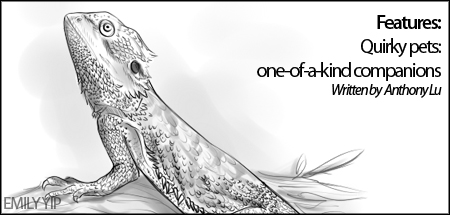
While some students own dogs, cats, or freshwater fish, some, like sophomore Ashley Lentz, have three ducks living in their backyard. A closer look at a few students at Aragon reveals that the variety of pet preferences are not at all limited to the most common.
Lentz acquired the three ducks when her mother’s third grade class hatched them for a school project. “Since I live on a beach, we thought it would be a perfect place for them to live,” says Lentz. “They just swim around and hang out around the house. They don’t go far because they don’t want to miss a meal.”
When her ducks were little, Lentz taught them how to swim. “We had to put them in the sink because they didn’t know how to swim by themselves. And when they got big enough to go outside, they would follow me into the lagoon in my backyard,” says Lentz.
Lentz says she must feed the ducks every morning and night. “They are very time consuming pets. Between cleaning up after them and feeding them, it’s a lot of work.”
However, she says that they make “great pets if you have the proper place for them to live.”
Biology teacher Katherine Ward has owned numerous unusual pets in the past including “leopard geckos, a chinchilla, fire-bellied toads, red-eared slider turtles, [and] a red-tail boa constrictor [named] Akuma.”
All of these lived in her old classroom, and most went to former students when she moved to her new room. She currently owns a pet colony of pill bugs.
“The chinchilla, Max, was really easy. It ate pellets,” says Ward. “What was interesting about it was . . . [that] [it] bathed in dust. It would roll around in its bowl of sand and make this big dust cloud.”
In addition to dust baths, Ward’s chinchilla took pleasure in escaping his cage. “I would do a cage check every day to make sure he hadn’t escaped,” she says. “Akuma, my snake, was also a very good escape artist. Once, he escaped and didn’t reappear again for three months. Akuma showed up on Back to School Night, not in my classroom but in a neighboring classroom.”
Senior Emma Walsh received her high yellow leopard gecko, named Ms. Marshall, as a gift from her aunt. “It has been in the family for 10 years,” says Walsh.
Geckos, according to Walsh, require a lot of maintenance, including heating pads, live food, and proper lighting. “I have to feed my gecko live crickets, so I also have to make sure the crickets are healthy and well preserved so my gecko can be healthy. They … smell. But the real challenge is that the crickets always escape, no matter what you do.”
“The best thing about my gecko is that she has little nubs for back legs. She has stumps so we call her ‘Nubkins.’ That’s how I got her,” says Walsh. She goes on to explain how Nubkins uses her nubs to balance herself across her bowl. “Her belly drags along the rim, her front legs edging her along, and then you see these yellow spotted stumps sticking straight out on either side of her body, sometimes rolling and waving around . . . using her arms to steady herself. It’s hilarious in a really sick way.”
Birds are common household pets too, in fact, Junior Jenny Qu owns eight chickens. “They’re very docile, they just roam around the yard eating grass,” she says. “I like them, every time you look out the window and see them, they’re very cute and fluffy.”
Qu says that caring for chickens involves having a coop and a big yard, plenty of food, a lots of care – she watches them to make sure they do not steal each others’ food.
“It’s just nice to have,” says Qu. “I have a dog too but it’s not as interesting. They’re the kind of pets you admire from afar. When they’re chicks you can touch them, but when they grow up they become just chickens and don’t let you touch them anymore. But they’re still very pretty. I just really enjoy having them around.”
Freshman Eric Carlson explains why he chose his bearded dragon named Rhino: “We already have a dog and a bird, so I thought we should go with something different.”
According to Carlson, bearded dragons are low maintenance, requiring feeding once or twice a day and not too much else. “Since it’s a desert animal, it gets most of its water from food.”
“You can take it out, but you don’t have to,” says Carlson. “Mostly they keep to themselves and do what they want. But they really like to be taken outside.” From chickens to pill bugs, Aragon is the home to not only a diverse student body, but also a colorful spectrum of quirky pets.




